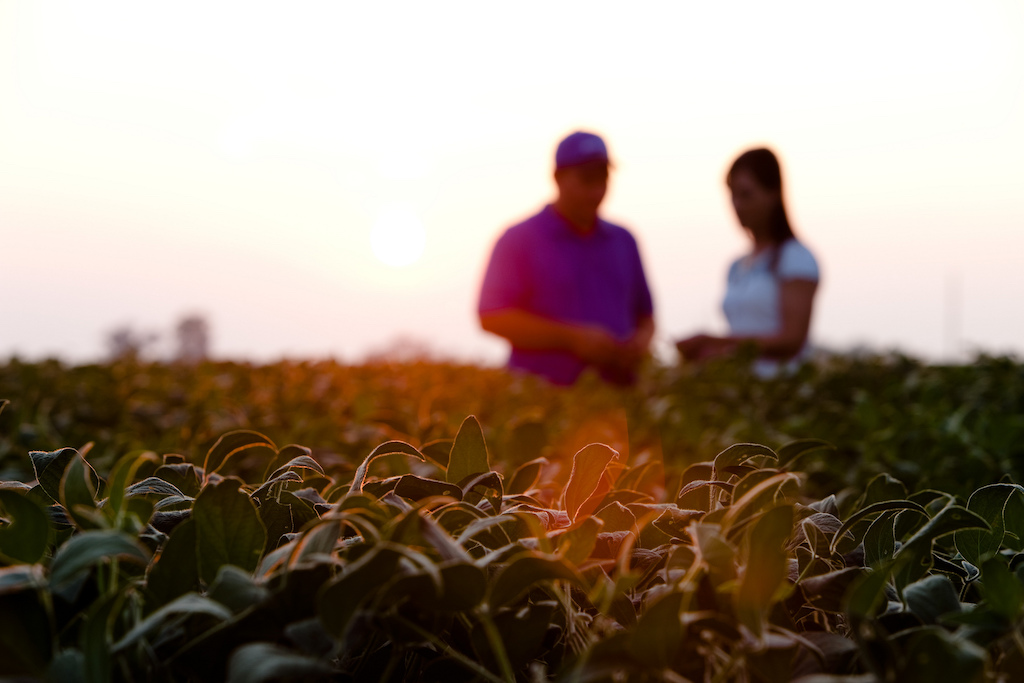Frustrated by what they see as a continued watering down of the standards that define what foods may be labeled “organic,” Patagonia Provisions—the food business offshoot of the outdoor apparel company, organic body care and food products company Dr. Bronner’s, and the research-based Rodale Institute will begin offering a new organic certification program.
Companies seeking the new certification, called Regenerative Organic Certification (ROC), will first have to secure the federal organic seal through the National Organic Program, the United States Department of Agriculture (USDA) agency that controls organic regulation. Then they’ll have to meet additional requirements to protect workers and guarantee a higher standard of animal welfare, among other things.
At the same time, several founders of the organic movement in the United States have started the Real Organic Project, which will offer a seal of approval to organic farmers who meet higher standards that it is setting for organic farming.
These new certification programs have brought to light a schism that has been growing for more than a decade in the organic business, creating a quietly expanding divide between companies and farms that do just enough to win the federal organic seal and those with practices that go far beyond the requirements set by the Department of Agriculture.
That the rift has now become public has raised concerns among organic champions, who fear that it will reduce the value of “organic” as a marketing and advocacy tool and confuse eaters who invest in products bearing the seal.
Mark Kastel, co-founder of the Cornucopia Institute, a non-profit organic advocacy group, says that while diehard organic eaters may devote time to understanding the nuances of three different organic labels, many more may just throw up their hands and decide it’s too hard to suss out their varied meanings.
A long-time adversary of the Organic Trade Association (OTA), Mr. Kastel has, somewhat uncomfortably, found himself on the industry trade group’s side in the debate over the new certification programs. “There’s a real risk that the new seals will turn products that just have the federal seal into second-class citizens, unable to command the premium prices needed for even the most basic organic production,” Kastel says.
In comments submitted to Regenerative Organic Alliance—the body overseeing the new Regenerative Organic Certification, OTA warned that another organic seal posed “a serious risk” to the federal label—which first went on packaging in the early 2000s. “As awareness of this standard spreads, so may the misconception that the USDA organic standards do not include requirements for soil health, biodiversity and animal welfare,” the group wrote. “Although not intended, this could present an unfortunate disservice to the livelihood of the organic sector and organic farmers across America.”
 Regenerative Organic Certified
Regenerative Organic Certified New certification programs have brought to light a schism that has been growing for more than a decade in the organic business
But David Chapman, an organic farmer in Vermont who is the spokesman for the Real Organic Project, says the standards in federal law and regulation are the bare minimum for organic farming and that USDA does little to enforce them.
Over the last decade, the department has revoked fewer than a dozen organic certifications in the U.S. as opposed to more than 80 in foreign countries, according to its Organic Integrity Database. It suspended just 1,700 certifications during that time.
Chapman says large companies hoping to cash in on the premium prices organic products command were doing as little as they could to stay in compliance with federal regulation. At the same time, they were counting on media coverage of small organic farming operations with shinier stories to convey a narrative about organic that doesn’t reflect the vast majority of farming federally certified as such.
“This is not creating divisions that don’t exist already,” Chapman says. “The industrial organic machine has been using real organic farmers as a sort of smokescreen, allowing consumers to think that farming the way I do it, say, is the same as the farming they’re doing—and it isn’t.”
Like ROC, Real Organic will require at a minimum federal organic certification. But it will not offer its additional certification to companies making processed foods; rather, its certification is for farmers who go well beyond the federal requirements. Mr. Chapman said about 20 farmers will participate in a pilot program this year, with a goal of putting the first seal on produce next year.
The project grew out of a decision last fall by the National Organic Standards Board (NOSB) that allowed companies growing fruits, vegetables, herbs and other produce using hydroponic and aquaponic systems to continue to use the federal organic seal. New technologies have greatly expanded the use of such systems, but organic traditionalists object to allowing produce grown that way to be labeled organic because it isn’t grown in soil.
The Organic Food Production Act of 1990 states that an organic plan, which is required for organic certification, “shall contain provisions designed to foster soil fertility, primarily through the management of the organic content of the soil through proper tillage, crop rotation, and manuring.”
Depletion of the nation’s soils has become a hot-button issue across farming at large after decades of pesticide application, tillage, and other practices that diminish soil health. Farmers are looking to crop rotation, reduced tillage, manure and other techniques to try to increase nitrogen stores in soil and enhance carbon sequestration.
“The problem is—and I hate it—the USDA has given up any claim that organic might have to do with leadership in soil health,” says Chapman. “I have friends who are not organic farmers, but they are definitely regenerative farmers doing pioneering stuff and doing a better job of protecting soil.”
A USDA spokesman pointed to notes provided to the House Appropriations Committee, explaining a request for an additional $3 million for enhanced enforcement of organic regulations. “With respect to goals, National Organic Program activities will have a strong emphasis on strengthening enforcement in order to protect the integrity of the label and allow for the industry to continue to grow,” wrote USDA.
“Under the existing organic standards, you can be an organic farmer and not do everything to the best of your ability to continue to improve soil health over time,” says Jeff Moyer, executive director of the Rodale Institute.
ROC will, for instance, require farmers to reduce tillage, one area where conventional farming has outpaced organic farming. (One of the selling points of genetically engineered crops is that they require little tillage.) “Particularly in organic vegetable operations, there may be too much tilling,” Moyer says. “If you’re an earthworm, doing your work to enrich soil, those are pretty rough days.”
Dr. Bronner’s and Patagonia Provisions are among 10 or so companies that will participate in a pilot program, but mammoth food companies like Danone, the French dairy business, and Kashi, owned by the Kellogg Company, have also expressed interest in the new seal. Roughly 20 companies applied to be part of the pilot, which will run for the next nine months or so.
“ROC brings everything together under one cohesive seal that signifies a product was grown in a way that’s good for the soil and good for the workers and animals involved,” says Justin Gold, the founder of Justin’s, the nut butters and snacks brand now owned by Hormel.
Organic traditionalists object to allowing produce grown that way to be labeled organic because it isn’t grown in soil
Danone’s chief executive, Emmanuel Faber, has long been a proponent of better care for earth and animal, and the company’s Happy Family, Horizon Organic, and Vega One brands are helping the development of ROC certification. “We have always been a strong supporter of the USDA organic standard,” says Michael Neuwirth, a company spokesman. “DanoneWave looks forward to concretely exploring and understanding how this proposed new certification will further benefit our planet through soil health, animal welfare, farming communities and more choices for our consumers and our business.”
Over the past several years, many of the oldest organic food companies and the farmers and stores that support them have become increasingly disenchanted with the National Organic Program, contending that it has loosened standards to accommodate big food businesses seeking to cash in on burgeoning consumer demand for organic products.
Sales of organic foods have grown strongly over the last decade, rising 8.4 percent in 2016, while sales of food overall conventional foods grew a meager 0.6 percent. Organic products, including clothing and health and beauty products, accounted for $47 billion in sales that year, according to the OTA.
And then there was the brouhaha over hydroponic and aquaponic production, or what its practitioners prefer to call “container growing.”
“While it is very convenient to blame both the Trump and Obama administrations, neither of which has been a friend to organic, the industry itself is culpable as well,” says Max Goldberg, founder and publisher of Organic Insider, a newsletter that broke the story of the ROC program. “There are organic companies who have representatives on the National Organic Standards Board, and these individuals voted for hydroponics. In my mind, this is a complete betrayal of the American organic consumer, who is under the impression that her strawberries and tomatoes have been grown in soil.”
Goldberg says he regards ROC as a kind of “gold standard for organics” but that establishing the new seal would not be easy. For one thing, he says, there is not yet an abundant supply of commodity ingredients like corn and wheat that will meet the higher standards. For another, explaining what the ROC seal means to eaters already confused by the proliferation of seals on food packaging will be a challenge.
And ROC’s founders agree that, at least in the beginning, products bearing the new seal are likely to be more expensive because of the higher standards it requires for production. “We know that there are consumers out there who want more transparency about the food they eat and are willing to pay for it,” says Rose Marcario, chief executive of Patagonia.
Marcario also contends that the new seal may, in fact, reduce confusion caused by the proliferation of seals on packaging because it implicitly covers practices policed by, say, fair trade or animal welfare certification groups.
“The ROC seal will mean that not only has the product received the approval of the federal organic program, it has also met requirements for regenerating and improving soil quality, treating workers fairly and with justice and treating animals with a high level of compassion,” Marcario says.
NSF International, the company behind one of the largest organic certification agencies, will act as the certifier for ROC during the pilot program, though Marcario says the aim is for other organic certifiers to join once the kinks are worked out. The seal should start showing up on grocery shelves early next year.
“We want to continue to support the work of the National Organic Program, but we believe there is an option for farmers who have been doing more than the program requires for decades to showcase the extra things they do,” she says. “Think of ROC as organic-plus.”















